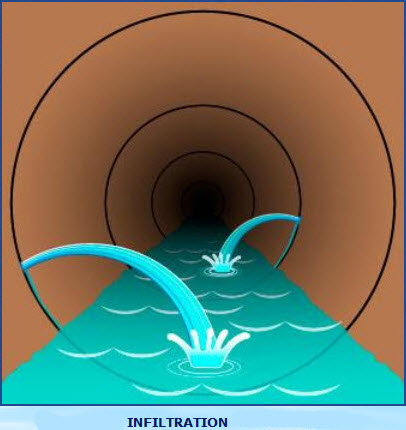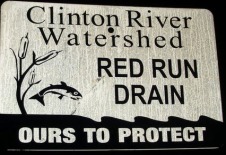Clinton River with G H Landfill leaks
All is NOT well along the Clinton River for autumn 2012.
Hazardous substances, pollutants, and contaminants STILL remain
above levels that allow for human exposure via casual recreational use
at the G & H Landfill site in Shelby Township, Michigan near
23 Mile Road west of Ryan Road.
~~~…~~~…~~~ CLICK on the pictures with your mouse ~~~…~~~…~~~
The EPA hammers home a “”protectiveness doctrine””
– the site is locked, fenced off, and has personnel on the grounds.
– deed restrictions preclude any form of use,
including recreational use; or future use;
that might impair/defeat any prior response actions.
The Deed = Estate of Leonard Forster aka G & H Landfill Industries.
– ALL is contingent on the onsite WWTP operating flawlessly
24/7 and 365 days a year for the past 20 years and into the future.
2011 was a very wet year with massive amounts of precipitation.
Many metro-Detroit municipalities got flooded.
How did the onsite (WWTP) waste water treatment plant cope – IT DIDN’T !
~~~…~~~…~~~ CLICK on the pictures with your mouse ~~~…~~~…~~~
MDEQ has questioned the adequacy of the groundwater monitoring network.
– The site currently lacks protocols to ensure the well integrity
for continued monitoring and extraction.
– Water levels have exceeded the top of collection pipes
throughout the past 10 years of operation.
– The containment system’s inconsistent adherence to performance objectives
indicates portions of the barrier wall are not functioning as designed.
September 2011 the EPA released its review
http://www.epa.gov/superfund/sites/fiveyear/f2011050004069.pdf
The Detroit Water & Sewer Department (DWSD) easement that runs through
the western portion of the site contains a 96-inch clean water supply pipeline.
The clean drinking water supply line was constructed in 1967 and serves as
the main distribution from Lake Huron to the Detroit Municipal Water System.
* The DWSD 96 inch drinking water main has been completely submerged
by chemical groundwater/leachate on more than one occasion.*
Lets hope there was no infiltration/inflow issues; it was built in 1967.
That’s a long time for leaks, cracks, splits, etc. to occur in the pipes.
People assume drinking water coming into their home is “clean”, “pure”, etc.
Landfill leaching is a factor in groundwater pollution.
It is generated by rainwater percolating through the layers of waste.
Tracking an underground plume of contaminants is difficult
and depends on many factors such as viscosity, density, etc.
A 3D map similar to a topographical map with Iso-Lines
can be created with horizontal and vertical transect contours.
Ninety-five chemicals have been detected at the G & H site.
That means 95 separate 3D plume maps; 1 for each chemical spread.
~~~…~~~…~~~ CLICK on the pictures with your mouse ~~~…~~~…~~~
Biogeochemistry of landfill leachate plumes involves:
a.) dilution
b.) adsorption
c.) precipitation
d.) degradation
e.) ion exchange,
f.) redoxx reactions
g.) heavy metals
The interpretation of groundwater samples from monitoring wells
determines appropriate remedial action i.e. – is the concentration
of dissolved contaminants in the leachate plume a real problem.
The landfill is overseen by an Environmental Contractor
CRA Environmental Services
Conestoga-Rovers & Associates Inc.
14496 Sheldon Road, Suite 200
Plymouth, Michigan 48170
Phone: (734) 453-5123
Fax: (734) 453-5201
CRA CLIENT: G&H LANDFILL PRP GROUP
DURATION: 1993 – ONGOING
COST: $16 MILLION
UPON 3rd Review – Site Inspection 5/26/2010 –
Review period: ( April 2010 – July 2011)
http://www.epa.gov/superfund/sites/fiveyear/f2011050004069.pdf
– Physical and hydraulic containment may not be functioning as designed
along the south wall of Phase II, at the southwest comer of Phase II,
along the Detroit Water and Sewerage Department water main,
and at the toe of Phase III
– The discharge and accumulation of orange colored liquids at the
Phase III landfill toe may indicate that hydraulic containment to
prevent off site migration; may not be functioning as designed.
– The current monitoring well locations and list of analytical
parameters; may not be adequate to determine protectiveness of the remedy.
EVERYTHING depends on the groundwater extraction and treatment system
functioning continuously – without hiccups, breakdowns, failures,
weather, acts of god, etc. That’s the onsite WWTP issue.
Part VII -Technical Assessment of the 3rd year review report
clearly states: — the remedy IS NOT functioning as intended
This area WILL NOT BE USED for any use by humans for a long long time.
It is effectively ruined for a few generations of Michigan residents.
~~~…~~~…~~~ CLICK on the pictures with your mouse ~~~…~~~…~~~
What about The Holland Ponds nature center and Heron Rookery ?
No one was going to chase the Herons away when they came to the trees.
The Herons didn’t know what had happened at the site,
they just realized it was unusually quiet for an urban setting.
The area is NOT wonderful “because” herons have nests in the trees,
it is merely an unfortunate coincidence these birds nest here.
Herons usually nest in colonies in woodlands that are
– within a few kilometers of their main feeding area;
– and relatively inaccessible to humans and land predators.
So the nest and feeding area, are not , necessarily the same.
Adult regurgitates pre-digested food, from a feeding area,
for the heron chicks to eat and develop.
This area next to the Clinton River has approximately 71 monitoring wells for
continuous groundwater samples and water level measurements.
The onsite Waste Water Treatment Plant operates 24/7 and 365 days a year.
A system of 80 above-ground vents are distributed across the site.
The G & H site was a sand and gravel quarry.
Chemicals were dumped en-masse from mid-1950s until mid 1970’s.
Ninety-five chemicals have been detected at the G & H site.
The Clinton River watershed is directly affected by this chemical landfill.
~~~…~~~…~~~ CLICK on the pictures with your mouse ~~~…~~~…~~~
Nearby is the Liquid Disposal Incorporated Superfund Site
It has it’s own set of nasty chemicals to contend with.
The EPA spent approximately $8 Million dollars cleaning it up.
The United States Environmental Protection Agency (U.S. EPA)
placed the G & H Landfill site on the
National Priorities List (NPL) in September 1983.
In December 1990, the U.S. EPA signed a Record of Decision (ROD)
– it included capping the landfill,
– installing a slurry wall around three sides of the landfill,
– installing a leachate collection system on the fourthside,
– pumping and treating groundwater from south and east of the landfill,
– providing municipal water to affected nearby residences and businesses,
– immediate closing of private wells for drinking water,
– excavating and disposing of PCB-contaminated soils and sediments
found outside the cap and slurry wall
In 2006 the EPA reported:
Long-term protectiveness of the remedy is dependent upon
– the continued effectiveness –
of the groundwater extraction and treatment system
in maintaining an inward hydraulic gradient
and removing contaminants.
Well it’s 2012 and it still has a fulltime WWTP struggling to protect
the Clinton River and the watershed where people want to fish/play.
– The next time someone says the Clinton River is just fine ,
have them read and reference the 2011 national EPA report.
Keep in mind, the DNR forces fish into the Clinton River manually.
I would like people to be actively involved in reading scientific
reports concerning the Clinton River and to think hard for themselves.
Cheerleading media hype with loud “”rah rah sis boom bah”” simply doesn’t
cut it when it comes to cold hard analysis about the health of the Clinton.
– The FEDERAL government EPA is reporting a failure affecting the river –
The Clinton River flows into Lake St. Clair and the Detroit River.
~~~…~~~…~~~ CLICK on the pictures with your mouse ~~~…~~~…~~~
EPA# – NPL – Site Name ———– Site ID ——- County —-
70——- Y—–G & H LANDFILL—- 50000009 —-MACOMB–
Project Manager —————- Phone —————– Unit—-
ZAKRZEWSKI, KRISTI ——-(517) 373-2937 ——–SASMU —









Trackbacks & Pingbacks